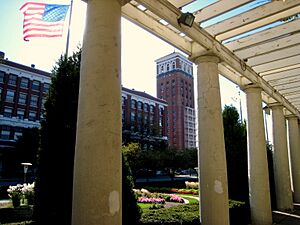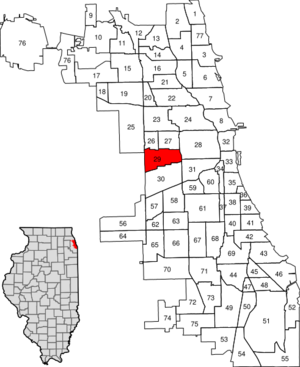North Lawndale, Chicago facts for kids
Quick facts for kids
North Lawndale
|
|
|---|---|
| Community Area 29 - North Lawndale | |

The former Sears Merchandise Building's Tower, as seen from the Sunken Garden
|
|

Location within the city of Chicago
|
|
| Country | United States |
| State | Illinois |
| County | Cook |
| City | Chicago |
| Neighborhoods | |
| Area | |
| • Total | 3.20 sq mi (8.29 km2) |
| Population
(2020)
|
|
| • Total | 34,794 |
| • Density | 10,870/sq mi (4,197.1/km2) |
| Demographics 2018 | |
| • White | 3.00% |
| • Black | 87.39% |
| • Hispanic | 8.83% |
| • Asian | 0.17% |
| • Other | 0.61% |
| Time zone | UTC-6 (CST) |
| • Summer (DST) | UTC-5 (CDT) |
| ZIP Codes |
parts of 60608, 60623 and 60624
|
| Median household income | $26,781 |
| Source: U.S. Census, Record Information Services | |
North Lawndale is one of the 77 community areas in Chicago, Illinois. It is located on the city's West Side. This area is home to the K-Town Historic District and the Foundation for Homan Square. It also has the largest number of greystone buildings in Chicago.
In 1968, Rev. Dr. Martin Luther King Jr. lived in an apartment in North Lawndale. He did this to show the difficult living conditions in the area. His experience helped lead to the Fair Housing Act. This law made it illegal to refuse to sell or rent a home to someone because of their race, religion, or other protected characteristics.
North Lawndale became part of Chicago in 1869. After the Great Chicago Fire in 1871, many factory workers moved here. They came to work at a new McCormick Reaper Company plant. Around 1890, many immigrants from the Austro-Hungarian Empire moved to the area. They built many Czech cultural centers and churches.
Later, around 1918, Jewish residents from Maxwell Street became the majority. They then moved north by 1955. In the 1950s, a new group of residents arrived: Black people from Chicago's South Side and the American South. They soon became the new majority. Some real estate agents used unfair tactics to encourage white residents to leave.
Starting in the 1960s, many businesses and people left North Lawndale. This was due to various challenges, including job losses and unfair housing practices. This led to many empty buildings and increased poverty. In 1968, local residents formed a group called the Contract Buyers League. They worked to fight unfair housing practices. This group helped many Black homeowners save money by renegotiating their housing contracts.
By the 1990s, North Lawndale began to see signs of improvement. New shops and restaurants opened, and the Homan Square area was developed. New residents, including Hispanic families, also moved in. From 2021 to 2022, violence prevention groups helped reduce gun violence in North Lawndale by 58%. This shows the community's efforts to make the area safer.
Today, there are ongoing efforts to improve North Lawndale. These include plans for new parks and affordable housing. The community is working to make sure these changes benefit everyone. In 2022, a new grocery store opened to help address the area's food desert problem. A proposal for a new STEAM academy was also made.
Contents
Exploring North Lawndale's Past
How North Lawndale Became Part of Chicago
North Lawndale was once part of Cicero Township. In 1869, the eastern part of North Lawndale joined Chicago. After this, streets were planned, and drainage systems were installed. A real estate company named Millard and Decker gave the area the name "Lawndale" in 1870.
After the Great Chicago Fire in 1871, the McCormick Reaper Company built a large new factory nearby. Many of its workers moved to North Lawndale. The rest of the area joined Chicago in 1889.
Early Settlers and Changing Communities
By 1890, many Bohemian immigrants from the Austro-Hungarian Empire began to settle in North Lawndale. They built churches and cultural centers. One important place was the Ceska Beseda (Bohemian Club), established in 1912. This club was a place for Czech people to enjoy art, music, and drama. Many wealthy Czech families lived in the area and were involved in local government.
Over time, many Czech families moved to the western suburbs. By the 1920s, Jewish families became the main group in North Lawndale. They had moved from the crowded Maxwell Street area. North Lawndale became the largest Jewish community in Chicago.
In the 1950s, Black families began moving to North Lawndale. They came from Chicago's South Side and southern states. Some real estate agents used unfair tactics to make white residents leave. In about ten years, the white population dropped sharply. However, the total number of residents actually increased.
Dr. Martin Luther King Jr.'s Visit
In 1966, Rev. Dr. Martin Luther King Jr. visited North Lawndale. He stayed in an apartment to show the poor living conditions, like broken doors and rodent problems. He used this experience to speak out against unfair housing practices across the country. His work helped lead to the Fair Housing Act.
| Historical population | |||
|---|---|---|---|
| Census | Pop. | %± | |
| 1930 | 112,261 | — | |
| 1940 | 102,470 | −8.7% | |
| 1950 | 100,489 | −1.9% | |
| 1960 | 124,937 | 24.3% | |
| 1970 | 94,871 | −24.1% | |
| 1980 | 61,534 | −35.1% | |
| 1990 | 47,296 | −23.1% | |
| 2000 | 41,768 | −11.7% | |
| 2010 | 35,912 | −14.0% | |
| 2020 | 34,794 | −3.1% | |
Challenges and Community Efforts
After the 1960s, North Lawndale faced many economic and social problems. Following the assassination of Martin Luther King Jr. in 1968, some areas experienced damage. Many stores closed, and by 1970, 75% of businesses were gone. Large factories like International Harvester and Sears also closed. This led to thousands of job losses.
As jobs disappeared, people couldn't afford to maintain their homes. Many houses were left empty and later torn down. The population of North Lawndale dropped from 124,937 in 1960 to 41,768 by 2000.
In 1986, the Steans Family Foundation was created to help North Lawndale. By the 1990s, they saw signs of improvement. New shopping areas and housing were built, especially around Homan Square. The population decline slowed, and new residents, mostly Hispanic, moved in.
North Lawndale has the most greystone buildings in Chicago. These beautiful stone buildings are being preserved. In 2004, Chicago started "The Historic Chicago Greystone Initiative" to help protect them.
The Contract Buyers League: Fighting for Fair Housing
The Contract Buyers League (CBL) was a group started in 1968 by North Lawndale residents. They fought against "contract selling." This was an unfair practice where Black homebuyers paid high prices and didn't truly own their homes until the final payment. If they missed a payment, they lost everything.
The CBL helped renegotiate 400 contracts, saving residents an estimated $25 million. Their efforts also pushed the government to change its housing policies. This made it easier for Black families to get fair loans.
Rebuilding and Revitalization Efforts
The closing of Sears and other businesses hurt North Lawndale. However, the old Sears complex was redeveloped into Homan Square. This project helped rebuild the community. In the mid-1990s, about 350 affordable homes were built. A new grocery store and a Starbucks also opened.
However, the financial crisis of 2007–2008 caused setbacks. The grocery store and Starbucks closed, creating a food desert (an area with limited access to fresh, affordable food).
In recent years, community groups have led positive changes. UCAN, a center for young people, moved to the area in 2016. Violence prevention groups like READI Chicago and Chicago CRED have significantly reduced crime since 2021. In 2021, the city also opened the Community Safety and Coordination Center. This center helps connect residents to various community resources.
In 2022, the neighborhood's first Black-owned grocery store opened. It gives away fresh produce to build trust in the community. This followed another Black-owned health food store that opened in 2018.
Neighborhood Highlights
K-Town: A Unique Name
K-Town is a special nickname for an area in North Lawndale and nearby neighborhoods. Many of its north-south streets start with the letter K. These include Karlov, Keating, Kedvale, and others. This naming pattern comes from a 1913 plan to name streets based on their distance from the Illinois-Indiana border. K was the eleventh letter, for streets in the eleventh mile.
A part of K-Town was recognized as a historic district in 2010. Writer John W. Fountain described K-Town as a "city within a city" where many Black families bought homes in the 1950s.
Homan Square: A Transformed Space
The site of the former Sears headquarters began to be redeveloped in 1988 as Homan Square. This project has brought new homes, a community center, a school, and a recreation center. Homan Square is often seen as a great example of North Lawndale's revitalization.
The old Sears tower was renovated and reopened in 2015 as "The John D. and Alexandra C. Nichols Tower." It now houses non-profit groups and youth organizations. The 14th floor is used for community events.
Getting Around and Learning
Transportation in North Lawndale
The Chicago Transit Authority's Pink Line train serves North Lawndale. You can find stations at Kedzie, Central Park, Pulaski, and Kostner. The United States Postal Service also has an office here.
In 2022, there were plans for the Altenheim Line. This would be an elevated park, similar to the Bloomingdale (606) Trail. It would be built on old train lines. Community leaders are working to ensure that new developments like this benefit current residents and don't lead to unfair price increases.
Education for Students
North Lawndale is part of Chicago Public Schools. High schools in the area include Farragut Career Academy and North Lawndale College Prep High School.
In 2020, North Lawndale saw a decrease in students. This was partly because people were leaving the city. Also, North Lawndale has many charter schools, and a high percentage of students attend them. There are proposals to create a new STEAM (Science, Technology, Engineering, Arts, and Math) elementary school in the neighborhood.
Famous Faces from North Lawndale
Many talented people have come from North Lawndale!
Arts, Literature, and Entertainment
- Shelley Berman (1925–2017), a comedian and actor.
- Andre Braugher (1962–2023), an actor known for shows like Brooklyn Nine-Nine.
- Steelo Brim (born 1988), a TV personality and host.
- Benny Goodman, a famous clarinet player known as the "King of Swing."
- Irv Kupcinet (1912–2003), a newspaper columnist and radio personality.
- Michael Peña, an actor in movies like Ant-Man.
- Ramsey Lewis (born 1935), a jazz composer.
- Kim Novak (born 1933), a famous actor.
- Harold Ramis (1944–2014), an actor, comedian, and director.
- Jean Terrell, a singer who became the lead singer of The Supremes.
- Twista, a well-known rapper.
- Dinah Washington, known as the "Queen of the Blues."
Athletes
- Kevin Garnett, a famous basketball player.
- Mickey Johnson, a basketball player.
- Darryl Stingley, a football player for the New England Patriots.
- Marques Sullivan, a football player.
- Ernie Terrell (1939–2014), a singer and former WBA heavyweight boxing champion.
- Isiah Thomas, a basketball player for the Detroit Pistons.
Business
- Julius Rosenwald, a co-founder and president of Sears, Roebuck & Co..
Military
- Hyman G. Rickover, a United States Navy Admiral known as the "Father of the Nuclear Navy."

